|
 
REBLOCHON
Savoie's
Best Cheese
Reblochon cheese was first made
in the XIIIth Century, in Savoie, in the Thônes valley.
In that remote time, farmers rented meadows (alpages)
from a landowner, and gave a proportion of the milk produced
as rent. When the rent payment was to be determined, the farmers
milked the cows incompletely in order to reduce the apparent
production, and thus their rent; once the landowner had gone,
the farmers would then conduct a second milking, which yielded
a milk rich in fat. This milk was then preserved by turning it
into cheese! The name Reblochon comes from patois, re-blocher,
which signifies to milk again.
Reblochon is made from whole,
unpasteurized milk and must meet rigorous standards to deserve
the coveted Appellation d'Origine.  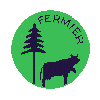 It
takes about five litres of whole milk to produce one cheese.
A ripe cheese may weigh between 450 and 550 grams.Two types of
Reblochon are produced: Reblochon Fermier, identified
by a green casein tag on the cheese's edge, is produced exclusively
on farms in the Thônes valley area; Reblochon Fruitier,
identified by a red casein tag on the flat face of the cheese,
may be produced in farmers' co-ops or cheese factories within
a larger area of Savoie and Haute Savoie. Connoisseurs prefer
the cheeses of June, July and August, as the cows have been eating
fresh young grass and flowers rather than hay; the milk and the
cheese are consequently more flavorful. Because Reblochon is
made from unpasteurized milk, it is seldom imported to the United
States, despite the rigorous veterinary controls which guarantee
a sanitary and healthful product. It
takes about five litres of whole milk to produce one cheese.
A ripe cheese may weigh between 450 and 550 grams.Two types of
Reblochon are produced: Reblochon Fermier, identified
by a green casein tag on the cheese's edge, is produced exclusively
on farms in the Thônes valley area; Reblochon Fruitier,
identified by a red casein tag on the flat face of the cheese,
may be produced in farmers' co-ops or cheese factories within
a larger area of Savoie and Haute Savoie. Connoisseurs prefer
the cheeses of June, July and August, as the cows have been eating
fresh young grass and flowers rather than hay; the milk and the
cheese are consequently more flavorful. Because Reblochon is
made from unpasteurized milk, it is seldom imported to the United
States, despite the rigorous veterinary controls which guarantee
a sanitary and healthful product.
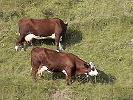  Reblochon
Fermier cheese is produced exclusively on farms near Thônes.
The milk from which it is made must come from Abondance, Tarine,
or Montbéliarde cows. After milking, every morning and
evening, the milk is collected and warmed in a copper vat; rennet
is added so that the milk will curdle. Reblochon
Fermier cheese is produced exclusively on farms near Thônes.
The milk from which it is made must come from Abondance, Tarine,
or Montbéliarde cows. After milking, every morning and
evening, the milk is collected and warmed in a copper vat; rennet
is added so that the milk will curdle.
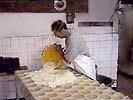 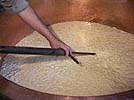 Once
the milk has curdled, it forms a large mass which must be sliced
with a comb, until the cheese particles are no larger than grains
of rice. The curds are then poured into molds which are covered
with a cheesecloth. The whey is collected and churned for butter. Once
the milk has curdled, it forms a large mass which must be sliced
with a comb, until the cheese particles are no larger than grains
of rice. The curds are then poured into molds which are covered
with a cheesecloth. The whey is collected and churned for butter.
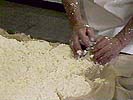 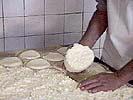 The
cheese is spread evenly by hand into the molds. Once the individual
cheeses have begun to take shape, they can be turned over in
the mold, which helps to give them their characteristic shape.
The coarse cheesecloth gives the cheeses their characteristic
surface texture. The
cheese is spread evenly by hand into the molds. Once the individual
cheeses have begun to take shape, they can be turned over in
the mold, which helps to give them their characteristic shape.
The coarse cheesecloth gives the cheeses their characteristic
surface texture.
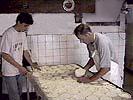 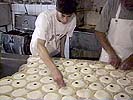 The cheeses must solidify for a good
quarter of an hour before they can be turned. Green casein medallions
are then placed on each cheese as a guarantee of their production
as true farm cheeses, The cheeses must solidify for a good
quarter of an hour before they can be turned. Green casein medallions
are then placed on each cheese as a guarantee of their production
as true farm cheeses,
"Reblochon Fermier".
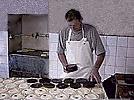 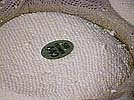 The
cheeses are then pressed to extract any remaining whey. Each
cheese is covered with a wooden disk made of larch; a five-pound
cast iron weight is then placed on top of the wooden disk. The
pressure gives the cheese its compact consistency and helps to
give it its texture. The
cheeses are then pressed to extract any remaining whey. Each
cheese is covered with a wooden disk made of larch; a five-pound
cast iron weight is then placed on top of the wooden disk. The
pressure gives the cheese its compact consistency and helps to
give it its texture.
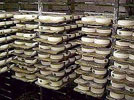 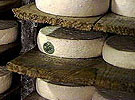 After
a quick soak in a brine bath, the cheese is stocked in a cellar
where it will age for some four weeks at a temperature not to
exceed 16°C. Each cheese must be turned over every two days
during the aging process. Once ripe, the cheese has a light beige
crust and a buttery dough. The white "moss" on the
cheese is edible and shows that the cheese was ripened correctly. After
a quick soak in a brine bath, the cheese is stocked in a cellar
where it will age for some four weeks at a temperature not to
exceed 16°C. Each cheese must be turned over every two days
during the aging process. Once ripe, the cheese has a light beige
crust and a buttery dough. The white "moss" on the
cheese is edible and shows that the cheese was ripened correctly.

You are visitor No
 to visit the Reblochon website!
to visit the Reblochon website!
Thanks for visiting.
Page and images
© 1996, 2001 by Robert
F. Jeantet
Updated 11 December 2001
end of the Reblochon
page
|